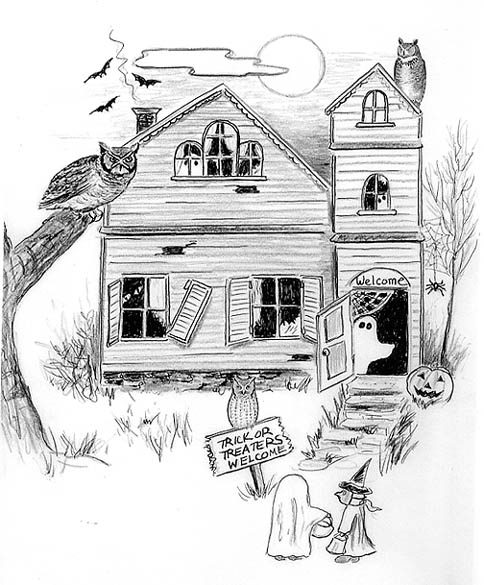
Dear Bird Folks,
We were putting up our Halloween decorations today and as I was hanging up a cardboard cutout of an owl, it made me wonder what owls have to do with Halloween. Ghosts and witches make sense, but why owls?
– Erica, Quincy, MA
Oh boo, Erica,
Don’t take this the wrong way, but I hate getting questions that require me to look stuff up. Off the top of my head I can tell you what owls like to eat, where they like to sleep and how far they can safely spin their heads around before they end up in traction. But, I’ll have to do a little digging in order find out why the Hallmarks of the world feel they need to put owls into their variety packs of Halloween decorations. Those packs always have the same items. In addition to the ghosts and witches you mentioned, let’s not forget about those other scary staples of the Halloween variety pack: skeletons, bats and the most menacing of them all, a cat. (How horrible!) But why owls? Owls are soft, warm and fluffy, and just because they can rip the head off a live animal and eat it in total darkness shouldn’t make them scary. Or does it? (If you reread that last line with the sounds of ominous organ music and a sinister laugh playing in your head it will have the effect I was going for. Try it again and you’ll see.)
Because owls are found all over the world just about every civilization has interacted with them. Apparently these nocturnal creatures made the local folks jumpy right from the start because even early cave drawings depicted owls in a menacing manner. The Romans, being educated, saw owls differently. They knew that owls were birds of the night and they were cool with that. However, the Romans would freak out if they saw an owl during the day. A daytime sighting of an owl was a bad omen, especially if a major battle was about to take place. In fact, the fall of the entire Roman Empire probably can be attributed to some insomniatic owl that left its roost too early one day.
The French couldn’t decide whether to be afraid of owls or not because they liked some owls, but not all of them. They were okay with owls that had ear tufts, but owls without ear tufts made them nervous. According to the legend, tufted owls were considered symbols of wisdom, but it was as sign of evil to see an owl that had no ears. That would explain why many French never liked van Gogh.
Some parts of Africa also had owl issues. In an area of what is now the Democratic Republic of the Congo owls were thought to be the cause of illness and were thus labeled “witchbirds.” Being afraid of owls is one thing. But in this part of Africa the witchbirds were persecuted to such a degree that one species, the Congo Bay-owl, was driven to extinction…at least temporarily. In 1951 the last known Congo Bay-owl was killed and none were seen again until 1996 when a female Congo Bay-owl was caught and identified by a researcher. It was great news. The Congo Bay-owls were back. Yea! (Easy for me to say; I don’t live near those witchbirds.)
In Malaysia it was thought owls would eat newborn babies. I don’t think this one is much of a stretch. Great Horned Owls have been known to take prey as large as a woodchuck; therefore, it is conceivable that a large owl could go after a newborn. However, I don’t think that’s a good reason to be upset with the owl. If you have owls eating your kids, it’s time to think about getting a new babysitter.
It should be noted that not all cultures feared owls. The Greeks thought owls meant that good fortune was on the way, and the Inuits looked to owls for guidance and help. But that’s enough about good owls. It’s Halloween and this column is about their dark side. We can talk about how wonderful owls are some other time. The question at hand is what do owls have to do with Halloween?
The origins of Halloween can be traced to Ireland, or Scotland or one of those other damp, foggy countries in that part of the world. At the end of every summer the locals would have a festival for the dead. During the festival it was thought that the separation between the present world and the after-world became thin and thus the spirits, both good and evil, could pass between the two worlds. In order to hide from the evil spirits, the people wore masks to conceal their identity. Get it? Masks? Halloween? How the owls became involved I don’t exactly know, but both Ireland and Scotland have strong negative owl superstitions. If either culture was going to have a festival for the dead, you can bet that owl images would be involved somehow.
There, Erica, that’s the best I can do. Our association with owls and the spooky time of Halloween, or any spooky time, dates back centuries. I hope that helps a little. Just don’t ask me why people started the tradition of giving out yummy Snickers and delicious MilkyWays on Halloween because I don’t know, but I’m sure glad they do it.